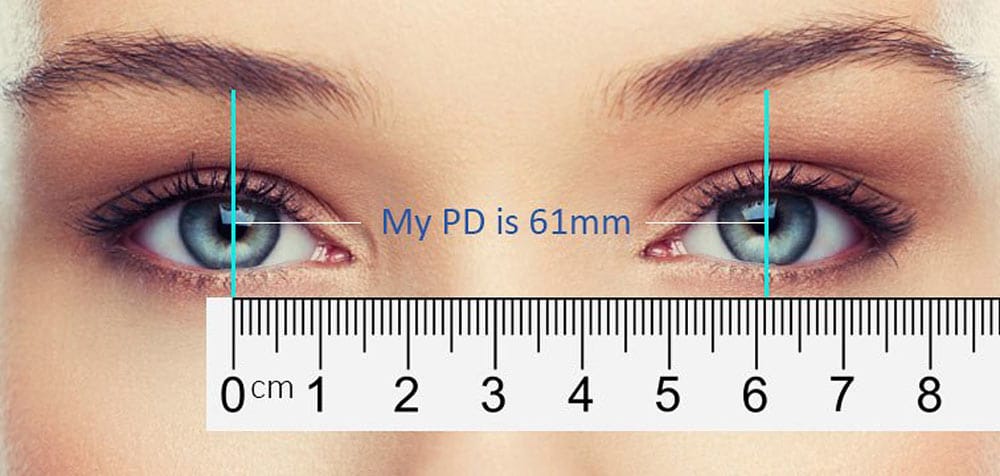Pupillary Distance and it's importance explained
Ordering glasses online is easy, you choose your frame and enter your prescription, but then it asks for your pupillary distance, you may never have heard of this before, so why is it so important now?
An accurate PD helps you to see clearly and comfortably reducing eye strain and potential headaches.
You may not find your PD on your glasses prescription but it’s pretty easy to measure it yourself, here are our tips on getting an accurate PD reading at home.
What Is Pupillary Distance?
Pupillary distance or PD is simply the distance between the centre of one of your pupils to the centre of the other, this is sometimes referred to as interpupillary distance (IPD) and is measured in millimetres.
Your PD measurement is used to centre your prescription accurately in your choice of frame.
Why Is My PD Important?
Every optical prescription has an “optical centre” and this should align with the centre of your pupils as you look through the lens of your glasses. When making your glasses the glazer will use your Pupillary Distance to get this spot as accurate as possible. The more accurate the measurement, the more comfort and clarity you will get from your glasses.
Where Will I Find My PD?
Your optometrist or dispensing optician will normally measure your PD using a pupillometer when you are fitted for a pair of glasses, however, this is rarely written down on your prescription, as it is used to make your glasses rather than forming an integral part of your optical prescription.
If you are lucky you may find your PD recorded on your prescription, if not you could ask your optometrist for your PD, failing that, don't worry, this is something that can easily be done at home.

How To Measure Your Own PD
Measuring your own PD is a simple process, you can use one of these three methods:
Measuring your own PD
Stand, or sit, 8 inches away from a mirror, whilst looking straight ahead and place a ruler against your brow. Close your right eye and align the zero mark on the ruler with the middle of your left pupil, then close your left eye and open the right eye to read the measurement that aligns with the centre of your right pupil. This is always worth taking this measurement 3 times to make sure of accuracy.
Getting a friend to measure your PD
Stand an arm's length away from your friend and look focus on something just above their head that’s about 10-20 feet away (across the room should work)
Get your friend to rest a ruler on your brow, align the zero point of the ruler with the centre on one pupil, and then read the measurement that aligns with the centre of your other pupil - this will normally be around the 64-millimetre mark, but could range from 54-74 millimetres. Ask your friend to take this measurement 2-3 times to check for accuracy.
Use an online PD measuring tool
Download an app such as Apple's Eyemeasure, or Google's Glasses On and measure your PD accurately in seconds.
Can I Use The Average PD?
The average PD for an adult is 64 millimetres for men and 62 millimetres for women, and this is often suggested for you on online stores, if you know your head is average size then this may work for you, however, 64 or 62 millimetres are only an average, and your PD could range from 54 to 74 millimetres depending on the size of your head, your gender or ethnicity. So if in doubt follow one of the methods above to get an accurate PD.
What If I Enter The Wrong Pupillary Distance?
If your PD is wrong by 1 or 2 millimeters you will probably not notice this, but the higher your prescription the more important it is to have an accurate PD.
If your PD is out by a few millimetres this could cause eye strain, headaches, or blurriness. If you experience any of these symptoms after wearing a new pair of glasses for two weeks then contact your optometrist or glasses provided.
How Do You Calculate Near PD For Reading Glasses?
Your Pupillary distance for reading glasses is generally smaller than your actual PD, to calculate your PD for reading glasses, first measure your PD then subtract 3 millimetres, so, for example, if your actual PD is 64, your reading PD will be 61.
Conclusion
As you can see the measurement of your Pupillary Distance is a crucial piece of information needed when buying glasses, however if you don’t actually know your PD then it is very easy to measure this yourself, which will ensure you have a comfortable well balanced and fitted pair of glasses whether you are buying from the high street or online.
Author: John Dreyer Optometrist Bsc(Hons), MCOPTOM, DipCLP
Created: 15 Oct 2023, Last modified: 7 Jan 2025

